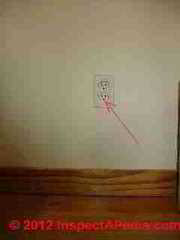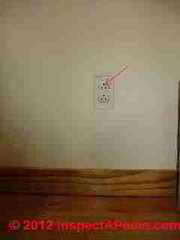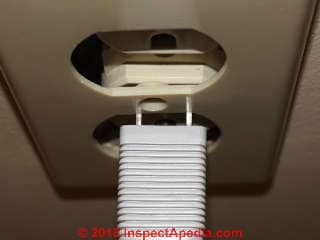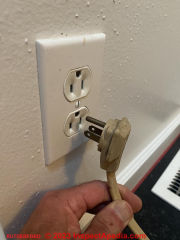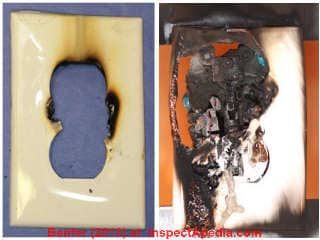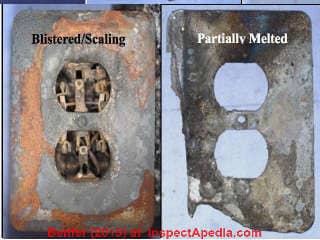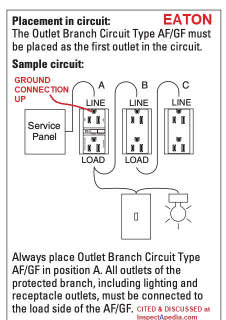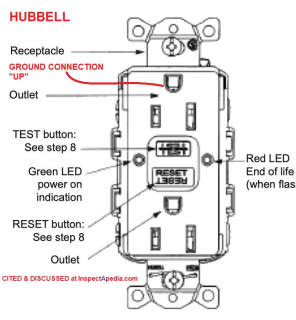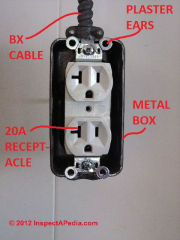 Electrical Outlet Ground Up or Down
Electrical Outlet Ground Up or Down
Which way should a receptacle be mounted?
- POST a QUESTION or COMMENT about how to install and wire electrical outlets or receptacles in buildings.
Does the electrical receptacle ("wall plug") go with the ground connector "up" or "down"?:
Here we review opinions of electricians and research authorities on the best position for electrical receptacles, with the ground-opening below the wall connector blade openings, as shown in our page top photo, or with the ground opening uppermost.
This article series describes how to choose, locate, and wire an electrical receptacle in a home. Electrical receptacles (also called electrical outlets or "plugs" or "sockets") are simple devices that are easy to install, but there are details to get right if you want to be safe.
InspectAPedia tolerates no conflicts of interest. We have no relationship with advertisers, products, or services discussed at this website.
Which end of electrical outlets go "up"? The ground hole should be up, down, or sideways?
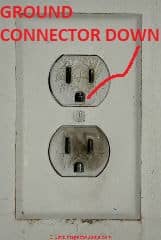 Can the outlet be installed any way? For example ground hole facing up, down, or sideways? thanks, - Anon
Can the outlet be installed any way? For example ground hole facing up, down, or sideways? thanks, - Anon
Bottom line: there is no code nor other definitive research requiring ground "up" nor for ground "down" at wall receptacles.
We found and include here some credible arguments for both positions, of which the ground-down argument has a longer list of supporting reasons.
Reader comments on which way the electrical outlet should be installed: Ground connector up or down?
One comment regarding 'inverted' outlet mounting (ground up, vs down).
[Click to enlarge any image]
While not specified in the code, I have noted that several electricians PREFER to mount a switched outlet so that the ground prong is up while mounting the non-switched outlets with the ground down. That way the homeowner can quickly determine a switched from anon-switched outlet. - Anon 9/5/12
(Aug 14, 2014) F. Rego said:
Thanks for the information - someone has said they like the ground prong up for a simple chance that if the ground prong is at the bottom and the extension cord gets somewhat loose and hangs that the two main prongs ( neutral /hot ) are exposed and it by chance some metal item may fall it could short it out or cause a spark and ignite (example: drapes ) as for the ground prong up all it will do is deflect it out of the way.
John said:
Our electricians at work told me that they prefer to install the outlets with the ground conductor up because it reduces the chances of a metal object (i.e. paperclip) falling off of a desk and landing between the neutral and phase conductor.
With the ground conductor up, there is a better chance of such an object getting deflected or falling between the neutral and ground, which would be safer than falling between the neutral and phase conductor.
Although there is still a chance that an object might fall between ground and phase, it would be less likely than if the ground conductor was down. Because a typical 3-conductor plug is triangle in shape, an object is more likely to be deflected falling on the ground side than the phase / neutral side. - 2 Aug 2015
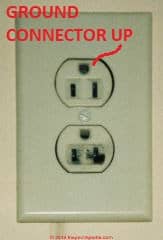 Reply: the position of installation of an electrical outlet won't affect its operation; insertion hazards at electrical receptacle slots
Reply: the position of installation of an electrical outlet won't affect its operation; insertion hazards at electrical receptacle slots
Anon, the position of installation of an electrical outlet won't affect its operation and should not normally affect its approval by the electrical inspector.
In some areas I see the outlet installed with the ground connector always "up" as in our photo, though to me that's less attractive than the position shown in our electrical outlet photo at far left.
There is an argument that ground-up is a safer installation for electrical receptacles that use a metal cover plate - as we discuss at RECEPTACLE BOX COVER PLATES
I've also seen arguments expressing the OPINION that the position of the grounding pin connector might help resist the tendency of a plug to fall out of its connection. That's nonsense.
Watch out: If a device plug is falling out of a receptacle, one of the two objects is worn or damaged and should be replaced to assure a safe, mechanically secure connection.
Anon,
About upside down electrical outlets - thanks for the interesting comment.
Unfortunately because there's no standard mount position associated with switched electrical receptacles, the next owner in a home will probably be confused unless the secret code is passed-on to everyone.
Falling Paper Clip Contacting the Plug Terminals vs Insertion Hazards.
Well as the Poughkeepsie police desk sergeant told our renter Anna M. when she complained that the Amtrack trains three miles away were too loud and that the cops ought to do something about it, ... "well that's one I've never heard before".
The claim that ground-connector up might reduce the chances of a live short across the hot and neutral spaces of a wall plug is technically plausible, though the probability of a paper clip or hairpin happening to fall onto a wall plug exactly into the gap that might appear at a wall plug that happens to not be plugged in far enough to prevent such contact seems to me to be very small.
It's the sort of explanation I used to make up before my friend Paul told me I was thinking too much and speculating too wildly.
What is a more-likely hazard at electrical receptacles is the insertion by children (or an adult fool) of a paperclip or other foreign object into the electrically live slots.
That concern has been addressed by research and by patents (Short 1989).
None of the patent citations considered the bad luck of a falling paperclip shorting an electrical receptacle or its wall plug. They all focus on inserted objects.
Thanks for the report, we'll keep it in the act.
Receptacle Installation Ground-Up with Metal Cover Plates
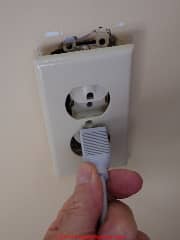 Reader Comment: install receptacles ground-up if metal receptacle cover plates are used
Reader Comment: install receptacles ground-up if metal receptacle cover plates are used
2018/08/14 Tom west said:
In cases where the outlet cover plate is metallic and held by the typical single screw, mounting the ground pin up prevents the cover plate from dropping across the phase and neutral conductors.
Of course, the cover plate screw would have to somehow be lost, but that never happens, right?
Reply: Yes, a metal electrical receptacle cover can fall and short circuit across wall plug connectors
That's an interesting observation, Tom.
I agree that it's possible for a receptacle cover to slide down and contact the prongs of a wall plug but in my OPINION that even is unlikely enough that it has not appeared in studies or standards that I have been able to find after several days of searching (August 2018).
In our photo above I have completely-removed the receptacle mounting plate screw and I have pulled out the wall plug to afford room for the cover plate to slip down into contact with the plug connecting spades.
Watch out: however during the removal or unplugging of a wall plug it is more-likely that the cover plate, if not secured, could drop, shorting the hot and neutral plug connectors.
In contrast, if the plug remains fully inserted, a loose receptacle cover cannot easily contact the plug connectors.
Below, using a plastic face plate for safety, I show the edge of the receptacle cover plate touching the plug connectors.
You will note that the mounting screw was removed and the wall plug was partly withdrawn from the electrical receptacle.
Watch out: don't try this experiment yourself as you could be shocked, burned, or killed.
Because I made these photos in our lab where fires and shock injuries are discouraged, I used a non-conductive Bakelite plastic receptacle cover to demonstrate how a receptacle cover could contact wall plug connectors.
Details of different types of receptacle (and switch) face plates including a list of the factors that determine the probability that a metal face plate will slide down to create a short circuit on the wall plug connectors are
at ELECTRICAL RECEPTACLE BOX COVER PLATES
Electrical Receptacle "Outlet" Ground DOWN Support
On 2023-04-16 by InspectApedia Editor (mod) - ground DOWN avoids accidental finger contact with hot wall plug spade
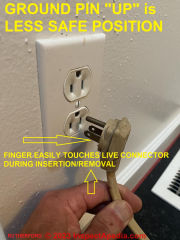 @Alan Rutherford,
@Alan Rutherford,
Ground up or down: NEC & Safest Position
Thanks for the photo, you're quite right - line cord wall plugs come in various orientations including with the ground connector "up" with respect to the line cord - as in your photo, or with it "down" and we've also got a few devices whose line cord wall plug can actually rotate to any desired angle (a more-expensive option).
Really? The line cord shown in your photo - in your hand - might want to actually be plugged-in upside down from how you're holding it if the line cord is going to extend upwards, for example to a large appliance like a microwave or a window air conditioner located above the wall receptacle.
So before we guess what the manufacturer of this line cord had in mind we need to see what's at the other end of that power cord and to know where it is going to be positioned with respect to the wall electrical receptacle or "outlet".
All of that means that the argument about ground-prong receptacle opening up or down a bit more debatable.
The U.S. National Electrical Code and the Canadian Electrical Code do not specify which direction is required: receptacles ("outlets") can be installed with the ground prong connector opening up or down - though there are plenty of opinions, some quite thoughtful, about which way is safest.
Still, I agree with expert Mike Holt's 1999 opinion: we prefer the ground in the lower or bottom or down position.
Mike pointed out that with the receptacle installed as in your photo, the installation is less safe as the ground prong can pull out while leaving the hot and neutral connectors still live or energized - a shock or even electrocution hazard, one that's increased as the line cord is being removed.
I think that this worry is why, as we see in your photo, the ground prong on the line cord plug itself is longer than the hot and neutral spaces of the plug.
The intention is that the ground should always be the last connector to break contact when the line cord wall plug is removed, and the first connector to make contact when the line cord wall plug is being inserted into an electrical receptacle.
Another argument for "ground prong down" in wall receptacles is that exactly as we can see in your own photo, the person's fingers are more-likely to be at the under-side of the line cord wall plug as it's being removed - a position in which a person's finger could cross the hot and neutral spaces (as in your photo) giving a bad shock.
On the other hand with the ground prong DOWN, the persons finger can only touch the ground connector, not a hot or live connector.
Summary of Points on Ground UP or DOWN at Electrical Receptacles on Walls
- Ground UP: A falling metal receptacle cover plate slipping down can contact hot and neutral if ground is DOWN - true, though nearly all new electrical work uses plastic cover plates. This is a possible, if probably uncommon hazard.
- Ground UP: a "more-stable" wall plug connection is provided.
Really? We're still looking for research and testing that supports this claim. It's important, especially where safety is a concern, that we distinguish between opinion and authoritative research and also between safety and aesthetics. - Ground UP for better help holding the wall plug in position? No supporting research has been found for this argument.
- Ground DOWN for better help in holding the wall plug in position? No supporting research has been found for this argument.
- Ground DOWN: for NEMA 14-50 ESVE Electrical Vehicle charging station connections gives an easier connection for some electric vehicle charging connectors. Standard is ground up but we've read on EV forums that many owners flip the receptacle over to ground down, e.g. for Porsche EVs.
- Ground DOWN: reduces stress on line cords that include built-in GFCI devices - as shown just above.
At wall plugs indeed experts have observed that the greatest stress and occasional breaking of some of the copper stands in the cord occurs where the line cord enters the wall plug.
Aronstein (personal communication to DF) points out that if you simply plug in an electric heater and then feel along its line cord with your hand, you'll often find that the hottest point is right where the line cord enters the wall plug.
We think that's because of wear and breaking of some of the multi-strand copper strands at that location - mostly-caused by people wiggling the wall plug as they remove it, but possibly also caused by bending-over of the line cord on devices like the one shown in our photograph above. - Ground DOWN: to avoid accidental finger contact with hot and neutral connectors is reduced, probably a more-common hazard than slipping-off metal receptacle cover plates. .
In our OPINION this is a reasonable argument supporting GROUND DOWN installation of electrical receptacles. See Alan's photo just below and note the position of his fingers, and see our annotated copy of the same photo above on this page.
On 2023-04-16 by Alan Rutherford - wall plugs come with ground connector oriented UP as well as DOWN
Plugs that lie flush come in both orientations.
Research: electrical receptacle installation position on walls, fires, hazards
- Allison, John. "Shock-resistant electrical outlet." U.S. Patent 6,455,789, issued September 24, 2002.
- Benfer, Matthew E. & Daniel T. Gottuk, DEVELOPMENT AND ANALYSIS OF ELECTRICAL RECEPTACLE FIRES [PDF] (2013), Hughes Associates, Inc., 3610 Commerce Drive, Suite 817 Baltimore, MD 21227 USA Tel: 410-737-8677 Webstite: www.haifire.com
This report has not been published by the U.S. Department of Justice. To provide better customer service, NCJRS has made this Federally funded grant report available electronically. NCJRS is the National Criminal Justice Reference Service.
Retrieved 2018/08/15, original source: https://www.ncjrs.gov/pdffiles1/nij/grants/243828.pdf
Abstract:
Laboratory testing evaluated the impact of a wide range of variables on the formation of overheating connections in residential duplex receptacles. Two types of receptacle configurations have been evaluated:
1) those focused on terminal connections and
2) those focused on plug connections.
Testing included 528 receptacle trials, 408 trials with various terminal connections and 120 trials with various plug connections. Thirteen pre-fabricated wall assemblies of 36 receptacles were placed in 8 compartment fire tests and 5 furnace fire tests.
The variables evaluated in the fire exposure testing included: the receptacle material, materials of the receptacle faceplate and box, terminal torque, and energized state of the receptacle.
A portion of the receptacles in the fire exposure testing had overheated connections that were created in the laboratory testing. These receptacles were used to assess whether evidence of overheating would persist after a fire exposure. All receptacles were documented for damage to the receptacle, faceplate, and outlet box including any arcing, overheating, and/or melting.
The results of laboratory testing indicate that only the loosest connections tend to form significant overheated connections irrespective of other variables, [emphasis added - Ed.] such as receptacle materials and installation.
Forensic signatures of overheating have been identified and have been found to persist even after external fire exposure. In addition, locations of arcing within receptacles as a result of fire exposures were identified and characterized.
The location of arcing is primarily dependent on the duration and intensity of the fire exposure, as well as the construction and materials of the receptacle, outlet box, and faceplate. The presence of characteristic indicators of arcing and melting were analyzed.
Role of Receptacle Faceplates in Electrical Fires
Benfer (2013) offers this description of the role of electric receptacle box cover faceplate materials:
In the fire exposure tests, both plastic and metal were used for outlet boxes and faceplates. The use of different materials aimed to address the impact of the materials on electrical damage and thermal damage to the receptacles.
For example, arcing can occur when energized conductors come into contact with properly grounded metal components. This cannot occur with the plastic outlet boxes and faceplates.
Also, the plastic outlet boxes and faceplates will melt and deform when heated in a fire, while the metal components (i.e., steel) will not. This may cause different thermal damage to those items and potentially affect the thermal damage to the receptacle. (Benfer 2013 p. 24).
Nylon receptacle box faceplates: ..., for faceplates used in the laboratory testing where an overheating connection was present, there was generally a darkened and charred area where the overheating receptacle would have been in contact with the faceplate....
... It is likely that hotter local temperatures present for the overheating connections caused the dark discoloration, but because they were localized, they did not cause the faceplate to fall off. Op. Cit. p. 132With increasing thermal damage, steel faceplates, like nylon, can partially-melt.
Steel receptacle box faceplates: The maximum temperatures for the partially melted faceplates were much lower than the melting temperature of steel. - Op. Cit. p. 137
- Gizienski, John J., Stephen P. Short, and Robert J. Mellen. "Safety electrical tap." U.S. Patent 4,867,693, issued September 19, 1989.
- Hall, John Raymond. Home electrical fires. [Book] Quincy, MA: National Fire Protection Association, 2013.
- Hall, J.R. (2010), “Home Electrical Fires,” National Fire Protection Association, Quincy, MA.
- Richardson, Michael T. "Apparatus for recessing an electrical device in a wall." U.S. Patent 6,750,398, issued June 15, 2004.
- Short, Stephen P. "Safety electrical receptacle." U.S. Patent 4,867,694, issued September 19, 1989.
Abstract:
An electrical receptacle is provided with a shutter mechanism to block spurious insertion of a foreign object through one of the receptacle slots short of the receptacle power circuit contacts.
This mechanism includes either one or two slides supported for movement between closed-latched and open positions.
Access to the contacts requires the slides first be unlatched by a blade penetrating one receptacle slot and then cammed to open positions by another blade penetrating the other receptacle slot, as occurs incident to the insertion of a standard electrical plug into the receptacle.
Reader Comments, Questions & Answers About The Article Above
Below you will find questions and answers previously posted on this page at its page bottom reader comment box.
Reader Q&A - also see RECOMMENDED ARTICLES & FAQs
On 2022-09-13 by Maint man mark
Ground down so if plug partially detaches from wall, the grounding is lost last. More safer ha ha
On 2022-02-18 by Inspectapedia Com Moderator (mod)
@Brian Keith,
Thanks for commenting.
The bottom line on this question is: there is no consensus, no single "always right" answer to which way-up for receptacles. There are arguments for and against both positions.
And despite a decade of research on this topic we have not found one scholarly research article or study that gives actual risk or performance data that would form a compelling "up" or "down" argument for the position of the ground connector on receptacles.
If you or other readers find such authoritative research do let us know so that we an add it here.
On 2022-02-18 y Brian Keith
Simple answer. Follow the listing organization as required by both OSHA and the NEC. If the manufacturer is NRTL approved follow the installation guide available either with the outlet or on the manufacturers website.
On 2021-12-01 by Inspectapedia Com Moderator (mod) - Informal Survey of Receptacle Ground Connection "UP" or "DOWN" in wall receptacle instruction pamphlets
Thank you for your comment.
Having researched this topic several times as well as fielded many comments as well as having installed and repaired electrical circuits for a long time, I have not found a - as you put it - definitive reason answer - so
in my OPINION there are just opinions and we have found no single compelling and authoritative "right" answer to the ground opening up or ground opening down argument.
There are advantages and disadvantages to either the up or down position of the ground prong connector.
First, we provide an an excerpt from Eaton's AF/GFCI INSTALLATION INSTRUCTIONS - Eaton [PDF] showing the receptacle with ground opening "up" - illustrated above.
Continuing our informal survey, Hubbell, another manufacturer, shows the receptacles installed with the ground connection "up" - illustrated just below, and excepted from
GFCI RECEPTACLE INSTALLATION INSTRUCTIONS - HUBBELL [PDF]
Also Lutron shows the ground connector "up" in these
GFCI INSTALL & TEST INSTRUCTIONS - Lutron [PDF]
But wait: here's another "Ground Prong Connector DOWN" example:
Leviton's non-GFCI receptacle installation instructions
show the receptacle with the ground connector in the "down" position - illustrated below and in
ELECTRICAL RECEPTACLE INSTALLATION INSTRUCTIONS - Leviton [PDF] for the company's Acenti model receptacle
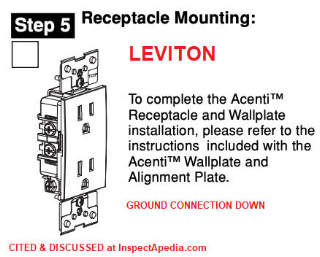
Shown below is an equivalent illustration from another major electrical receptacle manufacturer, showing the ground receptacle opening in the "down" position - from
GFCI RECEPTACLE INSTALLATION INSTRUCTIONS [PDF] from Leviton
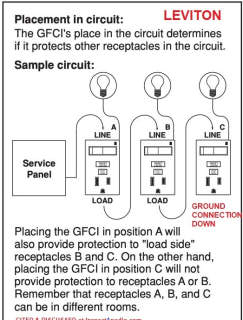
Really? The above are illustrations of electrical receptacles showing the ground up in some or down in others, excepted from the duplex or GFCI/AFCI receptacle installation instructions from several manufacturers.
None of these instructions tell the installer that the ground connection must be "up" nor do they insist it be "down". Wisely they've stayed out of the argument.
On 2021-12-01 by Carl - no website gives a definitive answer to ground up or ground down receptacle position
OK I've found no site that lays down any definitive reason answer - other than the impact of the rarely-used metal plate. But here's mine - while cords can be twisted, shorter ones like powerstrips seem to have the ground plug at the bottom.
So, while those in the industry may have varying technical reasons to vary, basic items seem to favor the one. And even if that's just ease-of-use and to not confuse average Joe, it means it'll never change.
On 2021-05-14 by (mod) - less damage likely to some power cords with the ground connection "down"
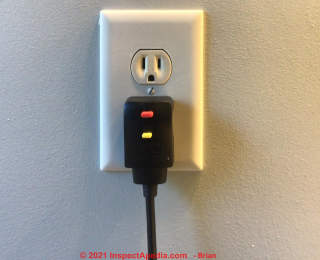 @Mr. Brian,
@Mr. Brian,
Thank you that's an interesting and very helpful remark. I agree with you completely.
I add that it's apparent from looking at the plug assembly itself that the manufacturer expects it to be positioned with the cord hanging down for the very reasons that you describe.
Or, put another way, the connector is designed for the way the manufacturer expects most plug-in connections to be made.
I've taken the liberty of flipping and straightening your photo lest we confuse other readers about "which way is the best way "up" for this receptacle"
Thanks again.
On 2021-05-14 by Mr. Brian
The reason I don’t like the up facing ground on an outlet is, items such as blow dryers have resettable breakers and mounting the ground up eventually causes a short in the wiring because it stresses the cord.
The picture I included is the ground facing down and won’t ruin the wire.
[Photo above]
On 2021-02-16 by danjoefriedman (mod) - receptacle manufacturers illustrate receptacles in both orientations: up and down for the ground connector
Thanks for the comment Vm
Bottom line: I have not found any receptacle manufacturer who, in their installation instructions, states that the ground opening should be up, nor one who states that the opening should be down.
On 2021-02-16 by vmelo
If you read the print on the face of a Leviton receptacle, where it displays the voltage, brand name and TR if Tampered Resistant then the Ground hole is up and neutral to the right, is Leviton telling us something?
Is this the way outlets should be installed. If so, all my outlets are upside down because I like the look of the ground hole down
On 2020-10-13 by (mod) - what if the receptales are "upside down"
That's ok though just which side is rightly "up" is not defined.
On 2020-10-13 by Anonymous
What if they are upside down
On 2020-09-13 by (mod) - electrician put gfci with ground hole up
MaryAnne
Thanks for asking;
As you'll read above on this page, it's a matter of much argument and a little concern which way the receptacle is installed
I am used to and prefer seeing the ground-prong opening "down" but some electricians are of the opinion that hole "up" is safer should a metal receptacle cover lose its screw and slip down to otherwise short the prongs of a wall plug in that receptacle.
My OPINION is that few new construction or renovation installations are even using metal receptacle cover plates, and that with a plastic cover plate the concern for a cover slipping down and shorting the circuit is, obviously, considerably-reduced.
In any event we are going to rely first on proper electrical wiring and overload protection by a fuse or circuit breaker of the most-critical safety feature at receptacles, not the mounting position of the receptacle itself.
On 2020-09-13 by Mary Anne
A Electrician came to the house with a trainee and changed out the GFCI switch in the Gararge outlet I noticedwhen the ground hole is at the top vs. the bottom like the rest of the outlets in house. Can this be done this way? Or do I need to call them back to do it as the rest in the house is ?
On 2020-02-09 by (mod) - no documentation claiming that UL listing requires ground prong hole up - nor down
Perley
Thank you, That's very interesting. It sure would be valuable to see an actual citation that documents The View that electrical receptacles are only listed with the ground opening up rather than down. I'll search some more but so far. I've been unable to find such a requirement for listing.
- Follow-up: our research found no documentation claiming that UL listing requires ground prong hole up - nor down. It is not specified.
On 2020-02-09 by perley urquhart
@Rusty,
Many years ago I attended a meeting of a local electrical associations that featured a representative from UL. A discussion arose about the very question ie; ground connection hole up or down. This Rep. offered that the UL listing was for ground prong hole up, as that was the method of testing.
On 2019-12-13 by (mod) - metal receptacle face plate came off and gave a nasty shock
Thanks Kyle, you make an important safety point -
I was wrong to imagine that "it won't happen" and ought to know better. A metal receptacle cover can slip down and bridge the the hot and neutral spaces of a device plug as it's being inserted or removed, causing an electrical arc and potentially a shock or even fire.
I'll be sure to keep the comment with the topic.
Daniel
On 2019-12-13 by Kyle
I had exactly the problem described in "Receptacle Installation Ground-Up with Metal Cover Plates".
The previous owner appears to have been just mechanically-inclined enough to cause problems - the screw holding the metal faceplate had been removed and replaced with a smaller-diameter one that didn't sufficiently engage the threads to provide any real securing force.
The faceplate came off when I was unplugging equipment, gave me a nasty shock across the knuckles, and proceeded to short hot to neutral. This ended up charring both the plug and the receptacle.
On 2018-11-26 by (mod) - there is no "standard" installation position for electrical receptacles in walls
Rusty,
Thanks for the question about "which way up" for the ground opening on a receptacle - as it is much debated and it's a topic sometimes visited by people with vehement opinons.
The fact - reliable fact - is that the electrical codes in both U.S. and Canada have never specified a requirement for the "up" or "down" installation position of an electrical receptacle.
And there is no "standard" installation position.
There are a couple of arguments for the ground-up position that appeal to some but that have not stood up to careful analysis.
1. that a loose metal receptacle cover plate can slide down to cause a direct short across the hot and neutral spaces of the plug (which of course should trip a breaker or blow a fuse). A careful analysis including one done here shows that such a short is possible but extremely difficult to achieve for a collection of physical reasons.
2. that the plug to wall connection is stronger with ground up - for which there is not a shred of physical evidence nor any scholarly study supporting that view.
3. That a paper clip or similar object could fall and short the receptacle - this is a similar case as #1 above though more possible physically than #1 - which is why we have breakers and fuses. After all a child can as easily push any metal object between a wall plug and the receptacle if the plug isn't fully inserted.
I have searched off and on for over a decade among electrical magazines, presentations, codes, and scholarly studies without finding even one report of these mishaps.
So if you or anyone have such a source I'd be very grateful to have it posted here.
On 2018-11-26 by Rusty
Please settle a long-standing debate between me and a contractor... Unless my memory is tricking me, I would swear to God that the original standard installation position of a standard double residential receptacle was with the ground prong on top.
My memory is that at some point this was reversed in California, or the entire nation, and the "standard" now is with the ground at the bottom of the three prong outlet. What is the actual TRUTH ?? Pls reply to russrogers333@gmail.com
Thank you!
On 2018-08-14 by (mod)
Tom
Thank you for the important comment and for discussing this ongoing debate on electrical receptacle installation position.
To have space for a detailed reply we repeat your question and offer our research results in the article above. Let me know what you think.
You may need to clear your browser cache or wait 24 hours for the modified article to appear in your browser.
Thanks again.
Editor
On 2018-08-14 by Tom west
In cases where the outlet cover plate is metallic and held by the typical single screw, mounting the ground pin up prevents the cover plate from dropping across the phase and neutral conductors. Of course, the cover plate screw would have to somehow be lost, but that never happens, right?
On 2017-10-22 by (mod)
Thanks for the comment, Audley.
However, the reasoning for installing ground up rather than ground down with a metal cover plate on a receptacle is not clear. If you can give that it'd be helpful for the discussion.
On 2017-10-22 by Audley Mckenzie
From Experience: You install the receptacle with the ground on the top when you use a metal cover plate.If the cover is plastic then it,s ok in any position. However most homeowner will like to see it down, it standout better in there eyes.
On 2018-12-22 by Gordon Stewart - entering the business office one afternoon, I heard an electric arc following by a scream.
Thank you for a thorough discussion of whether to install duplex receptacles with ground prongs up or down. A personal anecdote: My facility has stainless steel cover plates for all switches and receptacles and ground prongs are installed down.
On entering the business office one afternoon, I heard an electric arc following by a scream.
I found our financial officer holding her hand in pain. She said she had been shocked as she pulled a power cord from a receptacle.
I looked at the receptacle and saw that that the cover screw was missing, but the cover plate was in place. I looked at the keys she was holding and found one with an electrical burn mark. She admitted to having the keys in the hand she used to pull the cord from the receptacle.
A human error that would have been protected by reversing the receptacle.
Personally, until someone markets a tester for ‘upside down’ receptacles, I will continue to flip any I find.
This comment was posted originally at ELECTRICAL RECEPTACLE COVER PLATES
...
Continue reading at ELECTRICAL RECEPTACLE COVER PLATES or select a topic from the closely-related articles below, or see the complete ARTICLE INDEX.
Or see these
Recommended Articles
- ELECTRICAL OUTLET, HOW TO ADD & WIRE - home
- ELECTRICAL OUTLET ADAPTER SHORT CIRCUIT
- ELECTRICAL RECEPTACLE ARC PITTING
- ELECTRICAL RECEPTACLE CONNECTION DETAILS
- ELECTRICAL RECEPTACLE COUNTERTOP SPACING
- ELECTRICAL RECEPTACLE COVER PLATES
- ELECTRICAL RECEPTACLE HEIGHT & CLEARANCES
- ELECTRICAL RECEPTACLE LOCATIONS
- ELECTRICAL RECEPTACLE TYPES
- ELECTRICAL DUPLEX RECEPTACLE WIRING
- ELECTRICAL OUTLET, HOW TO ADD in OLDER HOME
- ELECTRICAL WIRE CLEARANCE FROM DUCTS & PIPES
Suggested citation for this web page
ELECTRICAL RECEPTACLE POSITION: WHICH WAY UP at InspectApedia.com - online encyclopedia of building & environmental inspection, testing, diagnosis, repair, & problem prevention advice.
Or see this
INDEX to RELATED ARTICLES: ARTICLE INDEX to ELECTRICAL INSPECTION & TESTING
Or use the SEARCH BOX found below to Ask a Question or Search InspectApedia
Ask a Question or Search InspectApedia
Try the search box just below, or if you prefer, post a question or comment in the Comments box below and we will respond promptly.
Search the InspectApedia website
Note: appearance of your Comment below may be delayed: if your comment contains an image, photograph, web link, or text that looks to the software as if it might be a web link, your posting will appear after it has been approved by a moderator. Apologies for the delay.
Only one image can be added per comment but you can post as many comments, and therefore images, as you like.
You will not receive a notification when a response to your question has been posted.
Please bookmark this page to make it easy for you to check back for our response.
Our Comment Box is provided by Countable Web Productions countable.ca
Citations & References
In addition to any citations in the article above, a full list is available on request.
- Timothy Hemm has provided photographs of various electrical defects used at the InspectAPedia TM Website. Mr. Hemm is a professional electrical inspector in Yucala, CA.
- [3] NFPA - the National Fire Protection Association can be found online at www.nfpa.org
- [4] The NEC National Electrical Code (ISBN 978-0877657903) - NFPA might provide Online Access but you'll need to sign in as a professional or as a visitor)
- US NEC Free Access: See up.codes at this link: https://up.codes/code/nfpa-70-national-electrical-code-2020
- [5] Special thanks to our reader Steve who pointed out prior errors in our illustrations.
- [6] Simpson Strong-Tie, "Code Compliant Repair and Protection Guide for the Installation of Utilities in Wood Frame Construction", web search 5/21/12, original source strongtie.com/ftp/fliers/F-REPRPROTECT09.pdf, [copy on file as /Structures/Framing/Simpson_Framing_Protectors.pdf ]. "The information in this guide is a summary of requirements from the 2003, 2006 and 2009 International Residential Code (IRC), International Building Code (IBC), International Plumbing Code (IPC), International Mechanical Code (IMC), 2006 Uniform Plumbing Code (UPC) and the 2005 National Electrical Code."
- In addition to citations & references found in this article, see the research citations given at the end of the related articles found at our suggested
CONTINUE READING or RECOMMENDED ARTICLES.
- Carson, Dunlop & Associates Ltd., 120 Carlton Street Suite 407, Toronto ON M5A 4K2. Tel: (416) 964-9415 1-800-268-7070 Email: info@carsondunlop.com. Alan Carson is a past president of ASHI, the American Society of Home Inspectors.
Thanks to Alan Carson and Bob Dunlop, for permission for InspectAPedia to use text excerpts from The HOME REFERENCE BOOK - the Encyclopedia of Homes and to use illustrations from The ILLUSTRATED HOME .
Carson Dunlop Associates provides extensive home inspection education and report writing material. In gratitude we provide links to tsome Carson Dunlop Associates products and services.


